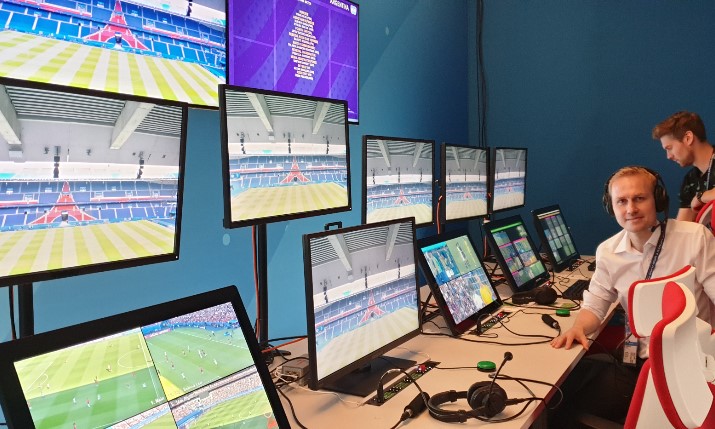Driving change: LiveU on how to unlock the value of the cloud and IP bonding for live sports

One of the four FIFA VAR rooms at the Parisian IBC for the 2019 FIFA Women’s World Cup
By Ophir Zardok, sports solutions and business strategy director, LiveU
Freedom. That’s the key word when it comes to IP bonding. It provides the freedom to choose how to cover an event and opens up the choice of what events customers want to cover, whatever their scale, from niche sports to Tier 1. It provides the ability to produce on-site or remotely with the choice of mixing and matching, depending on each event. And then there’s the emergence of cloud workflows to create the dynamic, fan-engaging content that drives advertising, sponsorship, viewership and monetisation.
2021 has seen huge growth in the use of IP bonding, with the weight of traditional ways of working no longer holding sports broadcasting back. This is not only about the flexibility and mobility of the field units themselves, but also the growth in cloud services, extending that flexibility beyond the content acquisition stage across the whole production. The ongoing emergence of cloud-based service growth changes the dynamic again and, as an industry, we’re only at the tip of the iceberg.
Sports use has been the fastest growing segment across the year around the world. We see this growth across all levels, from niche to Tier 1, and across all types. This is with both returning and new customers, and we’re talking about remote (REMI) and on-site production.
We’ve carried out a lot of analysis of the sports market, not least the role technological developments play in driving it and how they are opening up new opportunities, allowing us all to think and work far more effectively. IP bonding is driving the market, making dynamic live coverage of many sports possible, not least because of the cost-effectiveness compared to having to use satellite and fibre. Then there’s the inherent mobility, allowing customers to bring fast-moving sports, even from the remotest of locations, to fans everywhere.
It’s also crucial in creating the holistic coverage of events that the digital world demands. It’s not only for the professional sports market but also amateur competitions too, where coverage has previously been impossible, golf being a prime example. This massively increases the exposure of each sport, boosting monetisation.
Flexible and dynamic
Alongside the much-discussed growth in remote production, it’s the growth in cloud-based services, cloud editing being a prime example, that stands out across 2021. We’ve partnered with key cloud service providers to expand our offer to customers and we’ve been involved, with partners, in several innovative end-to-end remote workflows, including this recent SVG Europe award-winning entry.
This is a rapidly growing trend in the market and working this way provides new levels of flexibility and dynamism. It’s all about increasing viewership and fan engagement, integrating live video feeds with editing, publishing, clipping and other tools. There are more and more production companies moving to the cloud and they need a variety of pre-integrated cloud-based solutions. We’re investing a significant amount in this and are continuing to increase our capabilities.
We are seeing IP-bonding and cloud-led innovation all around the world, creating new possibilities at new price points. Taking football as an example, multiple feeds can be captured from different stadiums. These feeds can then be delivered to a remote location where they can be analysed. This can be achieved via a physical server at the remote location, but it can also be extended into the cloud and can be delivered anywhere, or, more pertinently, to wherever an analytics team is based. This is ideal for data capture about the match and the players involved. This can be done using RTMP feeds from cloud to cloud.
Many football organisations around the world want to introduce virtual assistant referee (VAR) solutions, not only for top tier matches but across lower levels, too. But existing VAR technologies are quite expensive. Using IP bonding, and partnerships with cloud-based technology providers, these feeds can be captured, sent to the cloud and then be picked up and viewed by referees in a remote venue and by referees in the stadium. Using this technology, communication between parties involved can also be achieved to rule on VAR decisions. We expect to see continued growth across cloud-based productions, not only in terms of event coverage but also analytics tools and other forms of data capture and analysis. We will continue to expand the partnerships we have to satisfy this demand.
Welcome to the main event
In 2022, the market is set to see continued growth in IP bonding use across sports. As an industry, we’ve reached a tipping point in the way that IP bonding is being used and, as importantly, the way it’s viewed in terms of reliability. When we look across the industry, one of the key changes that we’re all seeing is the rapidly increasing use for main sports feeds as well as back-up to main. This, of course, requires rock-solid signal reliability and is a step change in the use of this technology. There is now far more knowledge across the market about how it can be used and what it can achieve at previously unimaginable price points.
There’s growth across the sports broadcasting market globally and this is only set to continue, driven by rights holders, production companies, broadcasters and, certainly in the US, college sports. They are all exploring or moving to IP bonding.
We have entered a new era of sports coverage that’s being defined by the use of IP bonding, remote production and related cloud-based production and distribution services. We look forward to 2022!
